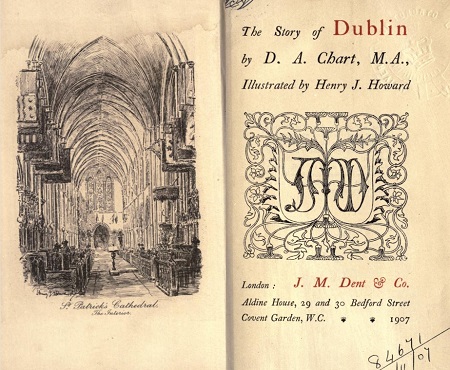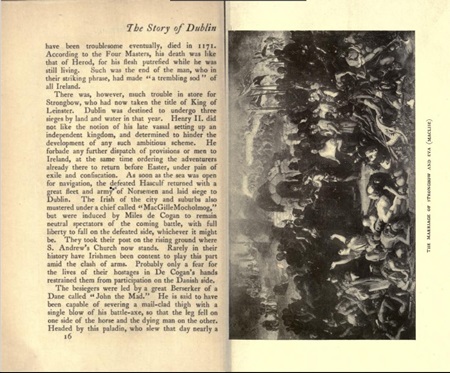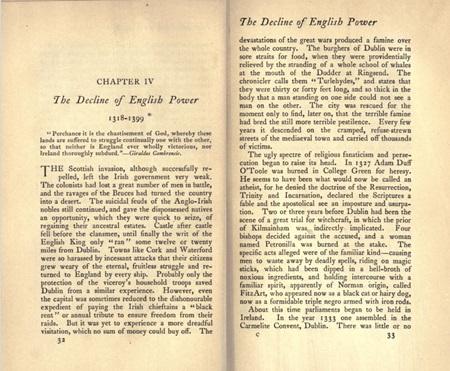Life
1878-? (David Alfred); became Master of the King’s Stationary, Northern Ireland; his The Story of Dublin (1907) in Dent’s Medieval Towns series was a direct source for phraseology in “Proteus” and “Wandering Rocks” episodes of Ulysses and parts of Finnegans Wake; also wrote An Economic History of Ireland (1920) andA History of Northern Ireland (1927); he later edited The Drennan Letters (1931) and issued A Preliminary Survey of Ancient Monuments of N. Ireland (1940);
Chart’s Story of Dublin was a source-book for Joyce’s Ulysses; Chart is arguably the first to use the word ‘Dubliners’ for the denizens of the city (Story, p.61); Chart shows himself a committed Unionist with a distinct sense of Irish and more particularly Anglo-Irish identity and a good deal of sympathy with the people of Dublin of all sects and septs, but whom he considered to be largely English.
[ top ]
|
COPAC lists early marriage published in journal Parish Register Society of Dublin, vol. 11 (1913) for St. Anne’s, St. Audoen’s, St. Bride’s, and St. Andrew’s churches. Also The 1851 Dublin City Census: Chart’s Index of Heads of Households, comp. & ed. by Seán Magee [Irish Records index, Vol. 3] (Dublin: Eneclann Ltd. 2001), which incls. the 1847 Ordnance Survey town plans. |
| The Story of Dublin (Dent 1907) - title-page & facing plate |
 |
| [See enlarged image - as attached; see further pages - as infra. ] |
|
||||
[D. A. Chart’s Story of Dublin (1907) is neither a work of great imaginative power nor a literary work of art but it is important in its character as material for Joyce’s rendering of the Dublin background of Ulysses (1922) and - as such - it merits considerable respect. It is given here in four media, html, word, text and pdf. The .pdf copies are two: firstly, a copy simply made by saving the Word text (.doc) in pdf format. Likewise, the .html copy in RICORSO derives directly from the Word version being saved as .html and then purged of specially Word format tags, which are very many indeed! Both of these are based on a Notepad copy (.txt) which has been extracted from the .html version given at Internet Archive and - on account of the inaccuracy associated with mechanical scanner and hasty edition - this is the rawest and most inaccurate of all.
For accuracy, the reader must go the the djvu copy which displayed as the default format in Internet Archive. This is a photographically extact copy of the original which has been reproduced in the distinctive page-turning format of that remarkable resource. of the two pdf copies given here, one reproduces the djvu pages in a scrollable format in lieu of the page-turn format of the online original while the other, as said, is simply a pdf copy of the Word file (.doc) based on the anterior Notepad record (.doc.) The difference in use is primarily that the .html and .doc versions can be reliably copied by any reader though checking with the .djvu version is strongly advisable whether in the .pdf version given here or the online original which has been made accessible above. BS Feb. 2024.]
Some pages in D. A. Chart, The Story of Dublin [Medieval Towns] (Dent 1907) Available at Internet Archive - online [click each image to enlarge in a separate window.
Criticism
There is a discussion of James Joyce’s indebtedness to Chart in James Atherton, Books at the Wake: Literary Allusions in James Joyce’s Finnegans Wake (S Illinois UP 1959; Arturus Books 1974), p.91.
[ top ]
Commentary
Liam Kennedy, remarks on Chart’s Ireland from the Union to Catholc Emancipation (London 1910), in which the author weighs what he considers industrial damage done by the Union with agricultural benefit and finds himself unable to strike an overall balance between gains and losses - an attitude which Kennedy characterises as ‘a most unusual position given the weight of unionist and nationalist orthodoxies by this date.’ (See ‘The Union of Ireland and Britain, 1801-1921’, in Colonialism, Religion and Nationalism in Ireland, IIS/QUB 1996, p.59.)
Quotations
The Story of Dublin (1907) - Chap. IV: The Decline of English Power 1318-1399 [On whales at Dublin]: ‘The burghers of Dublin were in sore straits for food, when they were providentially relieved by the stranding of a whole school of whales at the mouth of the Dodder at Ringsend. The chronicler calls the “Turlehydes,” and states that they were thirty or forty feet long, and so think in the body that a man standing on one side could not see a man on the other. The city was rescued for the moment only to find, later on, that the terrible famine had bred the still more terrible pestilence. Every few years it desceended on the cramped, refuse-strewn streets of the mediaeval town and carried off thousands of victims.’ (p.33.)
James Joyce: ‘A school of turlehide whales stranded in hot noon, spouting, hobbling in the shallows. Then from the starving cagework city a horde of jerkined dwarfs, my people, with flayers’ knives, running, scaling, hacking in green blubbery whalemeat. Famine, plague and slaughters. Their blood is in me, their lusts my waves. I moved among them on the frozen Liffey, that I, a changeling, among the spluttering resin fires. I spoke to no-one: none to me.’ [Bodley Head Edn., U56]
Note: Chart makes mention of the famine in Ireland caused by the invasion of Edward the Bruce, who turned away from Dublin towards Limerick seeing that they had defended it even at the cost of tearing down the cathedral for stone to make protective walls. (p.31.)
‘The Last Struggle of the Irish Clans under the English authority. They were not satisfied with the uncertain tenure of three or four counties near Dublin and a very nominal suzerainty over the rest of the land. So Henry VIII. crushed the semi-independent Geraldines, and even the Catholic Mary drove out her co-religionists, the O’Moores and O’Connors, from the districts of Offaly and Leix. In compliment to the queen and her husband, Philip of Spain, this conquered territory was formed into two new shires called King’s and Queen’s County, with Philipstown and Maryborough as their chief towns. Elizabeth carried the policy of her predecessors to a successful issue after a fierce struggle, which lasted the whole of her reign, often threatening to end in the utter defeat of the English and their expulsion from the country. The O’Neills of Ulster were the leaders of the Irish resistance to religious and political innovations. The city of Dublin, under the watchful eye of the able governors whom Elizabeth appointed, slowly became Protestant. There must have been grave searchings of heart among the halting citizens when the roof and south side of Christ Church Cathedral fell in only a few years after its adaptation to the reformed docriiies. A littie later a plague, the worst recorded in its annals, so devastated the city that grass grew in the streets, and the mayor fled out of the pestilential town to hold his court at Glassmanogue, near Phibsborough, while the viceroy Sidney removed the seat of government to Drogheda. These events were probably interpreted as the judgments of Providence on a heretical people. The municipality is found sometimes energetically assisting the Protestant and Anglicising party, sometimes so backward in the service as to call down the censure of the authorities. Thus, in 1566, the Dubliners heard that Shane O’Neill was besieging Dundalk, and was likely to [61] capture not only the town, but Lady Sidney, who was staying there and would be a useful hostage in Shane’s hands, while he negotiated with her husband. They marched out at once under their mayor Sarsfield, forced O’Neill to raise the siege, and returned to Dublin with the lady, defeating on the way an attempt of the Cavan O’Reillys to intercept them. Sarsfield was knighted for his gallantry. Two years later, however, a subsequent mayor was fined ^100 and committed to the Castle for refusing to perform his military duties. In 1577 the citizens took part in a great constitutional protest. Sidney, presuming too much on his popularity and prestige, had ventured to impose a tax by virtue of the royal authority alone without obtaining the consent of an Irish parliament. A deputation, including Lord Howth and some leading Dublin men, was sent to petition the queen against taxation without representation. Elizabeth received them very graciously, though secretly annoyed by their opposition. They were soon thrown into gaol for contumacy and resistance to royal command. Their sympathisers in Ireland were sent to Dublin Castle. But Sidney soon found his position untenable and was forced to procure the assent of the representatives of the Pale to his plans. The prisoners in both capitals were released. In the meantime the policy of the Irish government in regard to the native clans was succeeding. The viceroys conciliated the great chiefs and tried to Anglicise them. [...]’ (pp.61-62.)
‘Gradual Progress and Conciliation admirers. His Majesty is well-known to entertain a kindly feeling for both the country and the people. While his genius for producing peace and concord exerts its influence over his Ministers and his subjects on both sides of the channel, the ancient quarrel begun near eight hundred years ago by Strongbow may yet be reconciled. Then the old city on the Liffey, which has been successively a Danish stronghold, an English outpost, an AngloIrish capital, and a disaffected Irish subject town, may settle down into its true position as the centre and heart of not the least among the great confederation of free and prosperous nations, which compose the British Empire.’
An Economic History of Ireland (Talbot 1920) - with chapters on Plantation and Confiscation (p.25); The Land and its Produce, 1600-1800 (p.90); Commerce and Industry, 1600-1800 (p.121); Finance and Currency (p.151-[206]). [Preface:] "This volume has been written to furnish those interested in the economic aspect of Irish history with a general view of the trend of Irish development in that respect from the earliest to the most recent times. As this is necessarily to a large extent pioneer work, it is not to be hoped that the book will not suffers from defects and omissions, but, in vlew of the daily increasing importance of the subject, the author trusts that the account here given will be of value, not merely to scholars and students, but to all concerned in the welfare of the country. The authorities given in the footnotes will serve to some extent as a bibliography and may help those who wish to investigate more deeply special periods or particular branches Of the study.
Thanks are due to many kind friends for information, advice or suggestions, particularly to Miss C. Maxwell, Of Trinity College, Dublin; Mr. M. J. M’Enery, Deputy Keeper of the Irish Records; Rev. Bro. J. J. Crehan, and Messrs. W. F. T. Butler, G. O. Duggan, O.B.E., H. S. Guinness, and W. P. Geoghegan (for facts relating to history Of the firm Of Messrs. Guinness); J. R. Fisher, A. P. Magill, and Newman ThompsonNote that Andrew Philip Magill (1871-1941), cited above, was a senior civil servant who wrote a memoir of his time in service, 1913-25. He served as private secretary to Augustine Birell when Secretary of State for Ireland, and joined the Northern Ireland government as Minister of Home Affairs before retiring in 1925. The memoirs were edited by his grand-nephew as From Dublin Castle to Stormont: The Memoirs of Andrew Philip Magill, 1913-1925 (Cork UP 2003), 96pp.
[ top ]
References
University of Ulster Library (Morris Collection) holds An Economic History of Ireland (1920); A History of Northern Ireland (Belfast 1927).
Belfast Public Library holds The Drennan Letters, and other titles.
[ top ]
Notes
Irish Book Lover, Vol. 17 [q.d.], contains notice that D. A. Chart

